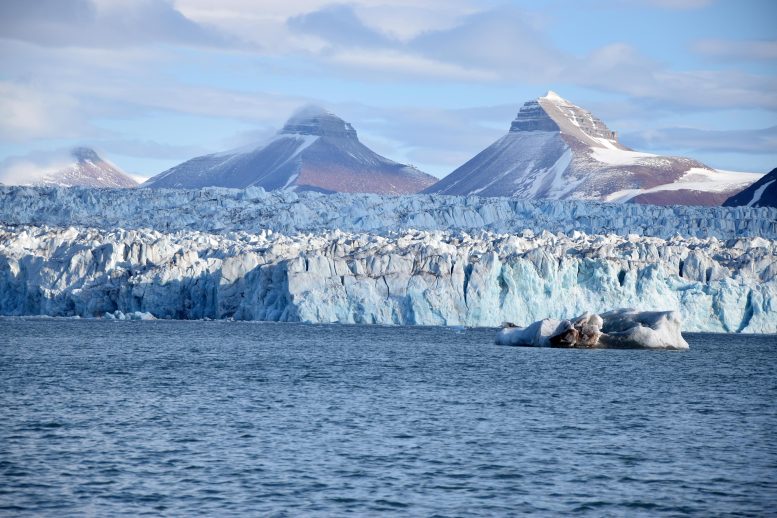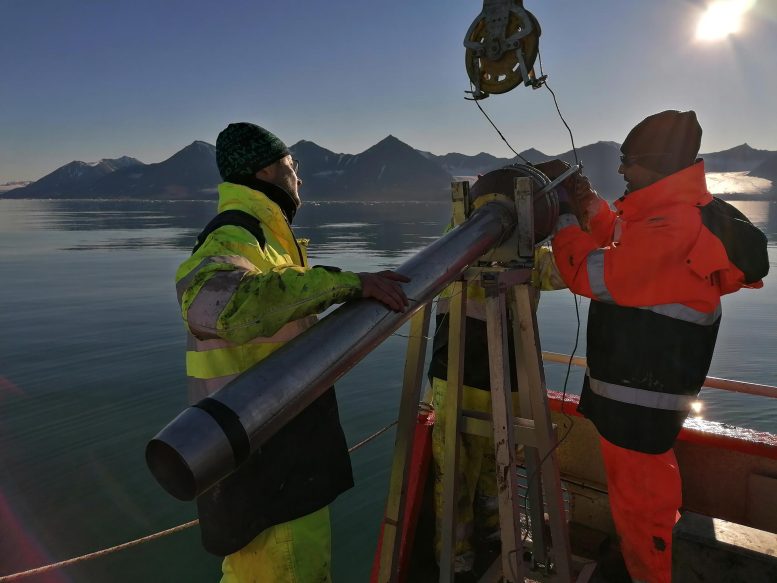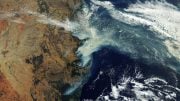
An international group of researchers reconstructed the recent history of ocean warming at the gateway to the Arctic Ocean in a region called the Fram Strait, between Greenland and Svalbard, and found that the Arctic Ocean has been warming for much longer than earlier records have suggested. Credit: Sara Giansiracusa
The Arctic Ocean has been getting warmer since the beginning of the 20th century – decades earlier than records suggest – due to warmer water flowing into the delicate polar ecosystem from the Atlantic Ocean.
An international group of researchers reconstructed the recent history of ocean warming at the gateway to the Arctic Ocean in a region called the Fram Strait, between Greenland and Svalbard.
Using the chemical signatures found in marine microorganisms, the researchers found that the Arctic Ocean began warming rapidly at the beginning of the last century as warmer and saltier waters flowed in from the Atlantic – a phenomenon called Atlantification – and that this change likely preceded the warming documented by modern instrumental measurements. Since 1900, the ocean temperature has risen by approximately 2 degrees Celsius, while sea ice has retreated and salinity has increased.
The results, reported in the journal Science Advances, provide the first historical perspective on Atlantification of the Arctic Ocean and reveal a connection with the North Atlantic that is much stronger than previously thought. The connection is capable of shaping Arctic climate variability, which could have important implications for sea-ice retreat and global sea level rise as the polar ice sheets continue to melt.

Using the chemical signatures found in marine microorganisms, researchers have found that the Arctic Ocean began warming rapidly at the beginning of the last century as warmer and saltier waters flowed in from the Atlantic – a phenomenon called Atlantification. Credit: Sara Giansiracusa
All of the world’s oceans are warming due to climate change, but the Arctic Ocean, the smallest and shallowest of the world’s oceans, is warming fastest of all.
“The rate of warming in the Arctic is more than double the global average, due to feedback mechanisms,” said co-lead author Dr. Francesco Muschitiello from Cambridge’s Department of Geography. “Based on satellite measurements, we know that the Arctic Ocean has been steadily warming, in particular over the past 20 years, but we wanted to place the recent warming into a longer context.”
Atlantification is one of the causes of warming in the Arctic, however instrumental records capable of monitoring this process, such as satellites, only go back about 40 years.
As the Arctic Ocean gets warmer, it causes the ice in the polar region to melt, which in turn affects global sea levels. As the ice melts, it exposes more of the ocean’s surface to the sun, releasing heat and raising air temperatures. As the Arctic continues to warm, it will melt the permafrost, which stores huge amounts of methane, a far more damaging greenhouse gas than carbon dioxide.
The researchers used geochemical and ecological data from ocean sediments to reconstruct the change in water column properties over the past 800 years. They precisely dated sediments using a combination of methods and looked for diagnostic signs of Atlantification, like change in temperature and salinity.
“When we looked at the whole 800-year timescale, our temperature and salinity records look pretty constant,” said co-lead author Dr. Tesi Tommaso from the Institute of Polar Sciences of the National Research Council in Bologna. “But all of a sudden at the start of the 20th century, you get this marked change in temperature and salinity – it really sticks out.”
“The reason for this rapid Atlantification of at the gate of the Arctic Ocean is intriguing,” said Muschitiello. “We compared our results with the ocean circulation at lower latitudes and found there is a strong correlation with the slowdown of dense water formation in the Labrador Sea. In a future warming scenario, the deep circulation in this subpolar region is expected to further decrease because of the thawing of the Greenland ice sheet. Our results imply that we might expect further Arctic Atlantification in the future because of climate change.”
The researchers say that their results also expose a possible flaw in climate models, because they do not reproduce this early Atlantification at the beginning of the last century.
“Climate simulations generally do not reproduce this kind of warming in the Arctic Ocean, meaning there’s an incomplete understanding of the mechanisms driving Atlantification,” said Tommaso. “We rely on these simulations to project future climate change, but the lack of any signs of an early warming in the Arctic Ocean is a missing piece of the puzzle.”
Reference: “Rapid Atlantification along the Fram Strait at the beginning of the 20th century” by Tommaso Tesi, Francesco Muschitiello, Gesine Mollenhauer, Stefano Miserocchi, Leonardo Langone, Chiara Ceccarelli, Giuliana Panieri, Jacopo Chiggiato, Alessio Nogarotto, Jens Hefter, Gianmarco Ingrosso, Federico Giglio, Patrizia Giordano and Lucilla Capotondi, 24 November 2021, Science Advances.
DOI: 10.1126/sciadv.abj2946
Francesco Muschitiello is a Fellow of Sidney Sussex College, Cambridge.









All such models are defective we don’t understand the global climate well enough to make a reliable model even for the entire planet. We also nave major issues on measuring the various factors that effect climate and the resulting changes. Thus massive and dangerous actions should be avoided like say geo engineering. Improvements and adaptation are the only log responses the planet will survive as will humans! To say otherwise damages yourself believable and should be avoided!
“It’s worse than we thought so we need to do less?” Are you a paid shill for the fossil fuel lobby?
A paid shill would use better punctuation.
So why are you ignoring the Chinese contribution to CO2 from their industrial empire. Regulations to reduce pollution, waste, contamination, emissions and crops in the Western World are only driving these industries to China and S.E. Asia, where regulations are viewed as anti-progress. Don’t you understand the concept of “Unforeseen Circumstances” ?
It’s not really “worse” at all. The overall temperature inclines are still the same, but the causation is what is somewhat different as the mass populations and worldwide industrialization didn’t exist to anywhere near the extent it does today back in the 19th Century with a world population at less than 1/4 of what it is now and massive countries like China largely being completely non-industrial. As some of us have realized for some time, there’s more going on than just man with climate changes. There’s also a natural warming trend since the end of the last Ice Age coupled by ever increasing world population (that doesn’t need to be industrialized to emit more C02 and/or methane, typically coupled with ever increasing domestic raised animal herds used to feed said population). Blaming technological progress rather than overpopulation and nearly zero attempts to limit human growth is largely missing the point, IMO.
Is it really the fossil fuels or is it because we now have over 8 BILLION people on the planet using them? Is the best solution to get rid of modern technology (which will eventually cure the problem when Nuclear Fusion becomes a reality) or should we have been looking at ways to curb population growth (other than wars over resources)? Do we really want to give up things like air conditioning to “fix” the problem by going backwards in technological comforts when we aren’t even looking at population concerns?
The problem is neither side of the “aisle” wants to be told how many children they’re allowed to have or put controls on who can have them so we’re left with ridiculous pushes to eat insects and worms, never travel and forgo modern conveniences like air conditioning in an ever hotter world as “solutions” when the core problem isn’t being addressed (overpopulation). Dan Brown’s novel Inferno had a dual-edged point to make and it’s not clear the “good guys” won at the end because it’s not that simple. As long as either side continues to push propaganda rather than deal with actual causation that almost no one wants to address, it’s a bit like spraying Lysol at a landfill. It won’t even really mask the problem, let alone fix it.
The polar ice caps began to form about 30 Myr-ago when CO2 began to drop from a high of about 1000 ppm to near 750 ppm. The climate at the time was mild. This should be clear evidcence that our current level of CO2 from the energy we have used is not a crisis or emergency. “atlantification” and Arctic “amplification” took place back in the warm 1920s and 30s when CO2 was barely above pre-industrial.
CO2 was probably higher than reported early in the 20th century due to the high usage of coal. Models will always be improved. Greater ocean masses with sea-level rise will provide some buffering with lesser landmasses. There are limited energy efficiency “modalities.” Ultimately, a stable planet requires less resource use and fewer people. We have not yet faced the policy consequences of our future.
They have tested air bubbles in ice samples and can also check tree ring data. They have a very good idea what the CO2 levels were. And they know that since the middle of the 20th century very precisely what the the CO2 levels were. Your comment is even nonsensical because you are saying that CO2 levels were higher than thought. That would not be the case, they would be lower than than thought since climate has been being impacted by human kind increasing the CO2 level for a lot longer.
Verified: Arctic Ocean ice is disappearing.
Verified: Ocean levels are rising in the Arctic and elsewhere.
Verified: Salinity levels in the Artic are rising.
Verified: This “trend” has been in-progress/process for longer than WE (whois we, Palefaces?) thought.
Verified: The rate of degradation is increasing; even as we speak.
Possible: There is something going on here that WE don’t understand.
Probable: There is a
COMPLEX “something” going on here that WE don’t WANT to understand.
Probable: WE can get back to you later on that.
IMPOSSIBLE!: WE can relax in the meantime and keep ignoring the OBVIOUS.
IMPOSSIBLE!: BUSINESS AS USUAL.
…Hmm… Didn’t see any mention of ALBEDO; particularly with respect to a CASCADING (EXPONENTIAL) TREND toward heat absorption, salinity increase and evapotranspiration from exposed Artic Ocean waters.
…Hmm… Didn’t see any speculation on what will happen when an increased “Connection” is established
between the North Atlantic and North Pacific via the Artic Ocean.
BUT! BUT! BUT!: ORGANIC trace changes indicate…
CONCLUSION: WE aren’t certain of anything.
CONCLUSION: Let’s WAIT AND SEE.
PROGNOSIS: WE’LL GET BACK TO YOU ON THAT.
PRINCIPLE IN PRACTICE: SOSDD.
CONCLUSION: WELL! I NEVER…
YEP! NOT A CLUE.
BAAAAAAAD MONKEY!
🐒
there has been many ice ages and much hotter times….we need to stop crying “the sky is falling, the sky is falling” and lock up these climate terrorists in newly reopened mental institutions… or shoot them and reduce their carbon foot print ..therefore solving two problems at the same time
I Love reading. I Prefer it to be the truth. All possibilities Encompassed. This is the great site for understanding better our environment and how we interact. Thank you for sharing all the great research and collaboration taken with colleges who thrive to understand the complex universe better. It makes for great reading and understanding. Also the comments are awesome…
The debate was never about whether climate was changing, the debate is always about what is causing it and can you actually do anything about it. Rational people have to acknowledge we don’t nearly know as much as we think we do about the cause and effect of climate change and therefore shouldn’t be proposing colossal changes that we have zero confidence will produce the output you think it will. Should we use cleaner more renewables in our energy supply? Of course we should, but not because it will reduce climate change but because it is better economically and better for the environment.
I still think its the polar shift(long over due), all the signs point to it.
The Earth is still in a 2.588 million year ice age called the Quaternary Glaciation(fifth ice age) in a warm period called an interglacial period that usually lasts 10,000 years, it has been 11,700 years. For the past million years, or so, under the influence of Jupiter and Saturn, the orbit of the Earth has cycled between an orbit that is nearly a circle like the present, when it is a warmer interglacial period, and a more elliptical orbit with the Sun at one focal point where the Earth is on average further from the Sun and is much colder called a glacial period. The cycle usually lasts about 100,000 years and cycles between a cold glacial period and a warmer, but still cold, interglacial like the current Holocene Period. There are about 190,000 glaciers that have to melt including Antarctica and Greenland that have to melt before we get out of this ice age and back to normal temperatures. https://en.wikipedia.org/wiki/Quaternary_glaciation
This will allow further refinement of models. Extrapolation is always risky, and there has never been a time in the history of the world as far as is known where the CO2 level has climbed so quickly. So far what was not known in creating the models has meant that the models have mostly underpredicted the temperature rise and impacts. That continued trends tend to be worse than predicted tends to indicate that there is that what is not accounted for is actually making the predictions of the models more optimistic. Add to that the need for scientists not make announcements about it maybe being much worse without adequate evidence, The human race is headed towards a cliff, and there is no one manning the brake.
Another Nail in the coffin for CO2 causing problems. Now, let’s have a look at North Magnetic Pole Shift. Started its trek right about the time of the Carrington Event, and temperatures rising along with causes from the sun-earth heliospheric-magntospheric interface and solar particle forcing. Where is the North Magnetic Pole right now? It is under the Eastern Gakkel Ridge, near the Gakkel Caldera. between Amundsen and Nansen Basins.
Just further proof of what I and many others have been saying, the heat is coming from below from the virtually unexplored deep oceans and also very likely connected in some way to magnetism and our rapidly moving magnetic pole. This is what causes drastic climate altering climate change NOT humans. Its been 780,000 years since the last permanent pole reversal and we had a short reversal 41,000 years ago that caused dramatic climate change on earth before the poles went back.
Then you have something like this as well, where it fits in I am not sure but I am sure humans are not responsible for any of this beyond say regional pollution.
https://theconversation.com/deep-sea-carbon-reservoirs-once-superheated-the-earth-could-it-happen-again-113518
Climate? ….That is a God thing and if you are not dealing with Him, then you are NOT dealing with Truth or Reality, and when THAT happens, you end up with our current sordid, sorry state of affairs we have today……what’s that you say? People who believe in Fairy Tales and Science are the Problem? HILARIOUS! Tell Santa THAT when you see him!